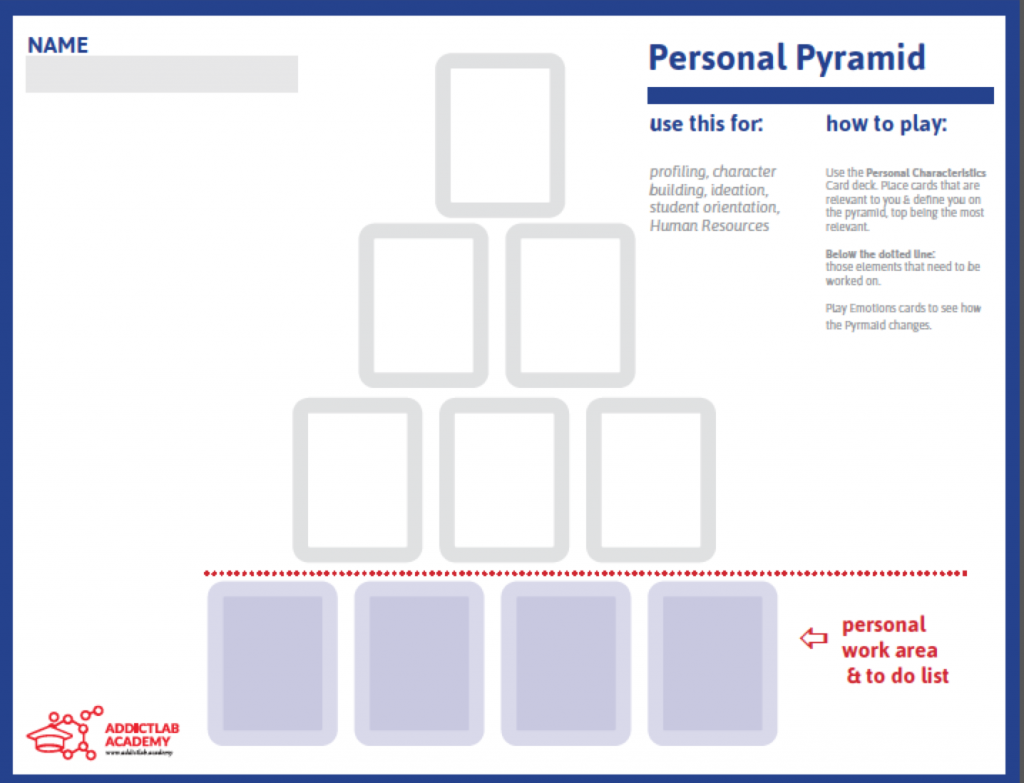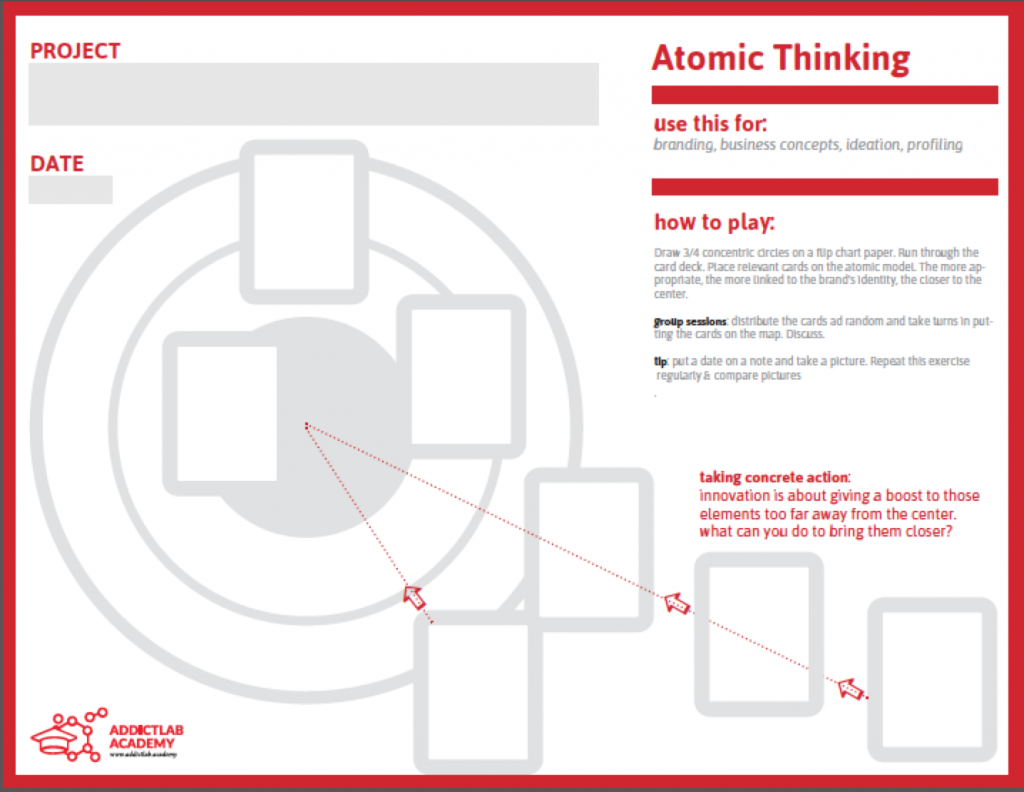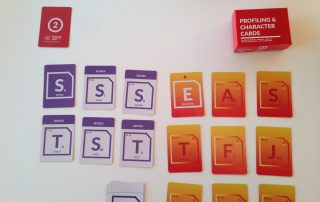The Creative Chemistry Table was created 20 years ago by Jan Van Mol when he founded Ad!dict Creative Lab. The aim : mixing creative disciplines, to get inspiration from other fields and cultures, and obtain more depth in the creation process. During the years, Ad!dict Creative Lab – or addictlab – conducted numerous brainstorming sessions, published over 35 books or magazines, and set up ideation processes for companies and organisations going from the Thalys trains, Lexus, Diesel, the chocolate and the design industry, to governments, cities and regions.
Today, the Creative Chemistry table consists of 140 disciplines or human ‘capabilities’, 76 character cards, the 17 sustainable development goals and more. This card set is a concrete package from a proven methodology to allow groups of people and individuals to think out of the box.The sets are used by Addictlab for its own research and creative think tank projects, and by YourOwnLab for its clients and third parties needing innovation and transformation, and by the Addictlab Academy for innovation in education through the school lab and science education projects. The card set is divided into different categories and is a unique tool for collective intelligence:
- profiling based on skills & passion
- out of the box brainstorming sessions & ice breakers
- strategic reflections
- business modelling
- ideation & cocreation
- student orientation
- personal introspection
Overview of all cards
Creative Chemistry cards.
About 140 creative disciplines. Divided into 13 categories, these are fields where we can be creative in. From photography to medicine, from tattoo to government. Categories go from Public Sphere, over Communication to Critical Thinking.
Character & profiling cards.
About 50 character cards based on the IB profile (International Baccalaureat). Cards on a person’s character and learner. ‘I am curious’, ‘I like to share’ and more.
Sustainable Development Goals cards.
The 17 Sustainable Development Goals as defined by the United Nations for 2030. We added 3 cards for an easy visualisation of the impact you create while designing or having ideas: how will your idea create a positive or negative impact on each of the 17 SDGs? And how can you adapt that idea?
Emotion cards.
8 basic emotions cards. Evident to use for personal profiling , but also because our ideas or ideation capabilities will be influenced by current, past or future emotions.
Gender cards.
To allow diverse gender profiling we added ‘male’, ‘female’ and ‘other’ genders.
Senses.
5 senses cards adding all 5 senses for future use.
Cards in preparation
Lab Curriculum cards: tools
These cards are currently being created with all the tools we have at our lab and we believe needed in any education program. Examples include 3Dprinters, VRstation, robots, laser cutters, but also traditional tools such as Kintsugi or Cyanotype photography.
This deck can be used combined with the Lab Curriculum cards: challenges.
Cards in preparation
Lab Curriculum cards: challenges
These cards are currently being created and consist of the growing amount of challenges we believe participants to our educational programs should be able to solve. The challenges are colour coded, increasing in difficulty, time, use of tools and overall maturity of the participant.
Lab activities thus can mean solving a challenge using a tool that is not know, or using a tool that is known to solve a new challenge.
Challenges are linked to the SDGs, but also contain important 2021 capabilities such as collaboration, reflection
How to play
 1.Skills & Passion.
1.Skills & Passion.
use this for:
profiling, collective intelligence, defining groups for brainstorm sessions, ice breakers
set up & play:
Draw two big circles on a flip chart as shown. One for your skills, one for your passions. Make sure the intersection area is big enough.
Write your name on the top left corner or put a personal profile card*.
Select the fitting cards and put them in one of the three areas.
tips for facilitators:
Add the date and take a picture to document. Archive it. You might want to do the same every year and see the changes. For brainstorm sessions: use this for forming small groups and initialise discussions – based on the right side (passion & skills). Hang on Idea Wall to showcase the audience present.
download template: CARDBOARD_DEF01
 2. Ice breaker and conversation starters.
2. Ice breaker and conversation starters.
Use this for:
profiling, ice breakers, group ideation, character building, story telling
set up (version 1 ‘4 and open’):
Take 3 Creative Chemistry cards and 1 Character and profiling to profile yourself. Put the cards in front of you with the elements up for all to see. Take turns: pick a card from a player, who needs to tell a story related to that card. Why did she/ he selected that card?
set up (version 2 ‘present through SDG’):
Take one of the SDG cards that is most related to you. Most important, most linked to the business you’re in. Explain.
TIP : add a card from the Emotion deck to give depth to the conversation
set up (version 3 ‘draw and tell’):
Put all cards upside down on a stack in the centre. Take turns, and (1) draw ad random or (2) select a specific card for someone, who needs to tell a story/personal experience related to that card. Then it’s her/his turn.
Available Accessories:
- Download template board_story
- Use the ‘Ice breaker’ board (optional)
 3. Personal Pyramid.
3. Personal Pyramid.
use this for:
profiling, personal introspection, character building, Human Resources, Student Orientation, branding and personal branding
set up:
Draw the Personal Pyramid using the template.
play:
Select those cards that are relevant to you & define you. Put them on the pyramid, the top level being the most relevant.
Below the dotted red line, add those characteristics that you believe you need to work on.
tip
Document & archive: take a picture of the pyramid, and repeat the exercise regularly to see evolution.
for HR and schools/teachers
Obviously, this can be done ‘about’ a person by HR departments and teachers, with or without the presence of the person at hand.
Available Accessories:
- Download template board_pyramid
- Use the ‘Personal Pyramid’ board (optional)
 4. Atomic Brand Model.
4. Atomic Brand Model.
use this for:
branding, business concepts, ideation, profiling.
Brands are almost ‘intangible’, as it is defined by elements (‘brand molecules’) such as products, heritage, building, people, etc. A brand can be defined as the point of gravity of all these elements. Even though what defines your brand is continuously in motion, this exercise will visualise your brand’s identity. The exercise will also point out those areas that need to be worked on, to bring them closer to the nucleus. – ‘Innovation is a boost of energy to those elements too far away from the centre. Define what they are and inflict that boost. What can you do to bring them closer to the point of gravity?’ from the Quantum Leap theory for brands (Jan Van Mol, Ad!dict on branding, 2008)
The Atomic Branding Model generates a much needed definition of ‘innovation’, ‘marketing’ and ‘branding’.
set up:
Draw 3 or 4 concentric circles on a flip chart paper or use the Atomic Model board.
play:
Run through the card deck. Place relevant cards on the atomic model. The more appropriate you believe it to be to the brand, the closer to the centre. Take turns. Now discuss: how can you bring those elements that are too far away from the center, closer? What are the concrete steps to take?
tip:
- put a date on a note and take a picture. Repeat this exercise regularly & compare pictures.
- Add empty cards : give freedom to the participants to add more cards, as there might be specific elements that create the brand at hand.
 5. Sustainable Development Goals Impact.
5. Sustainable Development Goals Impact.
set up
Take the Idea card, and put in the middle. Put the (+) positive impact card to the left, and the the (-) negative impact card to the right.
play
Put your idea, concept, product, object of discussion on the idea card. When intangible, use a postit to describe the idea, and stick it on the Idea card. Distribute all of the 17 SDG cards ad random, and take turns. Evaluate whether the idea will create a positive or negative impact on the SDG card you are holding. When not relevant, put it down and turn the card upside down. When the idea would create a positive impact , put the SDG card next or under the (+) card. When it would create a negative impact, put the SDG card under the (-) card.
document
take a picture and archive.
idea iteration
Now how can you adapt the idea, concept, project, object of discussion so that the negative impacted SDGS disappear (at least), or can be put next to the (-) (at best)
Available Accessories:
- Download template
- Use the ‘SDG impact’ boards (optional)
- Use the ‘SDG impact kit’ panels (optional)
6. Time Line.
set up & play
Draw a line representing the timeline of your project/business. Put relevant human capabilities and competences to indicate when in the process you will need them. Discuss and document. Repeat and compare to previous sessions.
tips
- try to cluster and name the different steps.
- add profile cards to put a face on the people you’d need for each step.
7. Inflict inspiration (quickplay).
You have a project to do, but you need new angles and inspiration, yet don’t know where to start? Take the deck, shuffle it, and draw a card. You – or in group – now have to add input from that card in your project. Input can be defined as inspiration, stories, people, practices you can come up with.
Tip for a brainstorm session.
First define people’s passions (see skills & passion). Take a picture of all present. Collect all cards that people in the group have defined as their passion. (facilitator)
Start ideation in small groups. Use the collected stack for this exercise: add one of the cards to inflict inspiration. But in this case, you can invite the respective person(s) as fresh input to your project, since he/she will be in the room.
8. Your ideas here.
Experiment with the complete card set. Did you find other ways of using the cards? Let us know!
All Creative Disciplines
Download here the 2019 selection of all disciplines as produced in the Creative Chemistry Boxes.
How to buy.
- To avoid stocks and unnecessary over-production, these boxes are produced on demand yet using grouped production when possible. Could take 3 to 4 weeks. Addictlab will get in contact re possible shipping costs or alternative delivery.
- Would you like to pay in Euros? You can pay our Belgian company LAB.001. Contact info@addictlab.com






